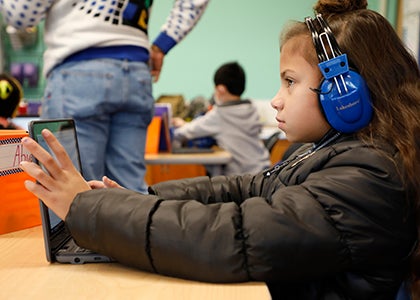Students Participate in Week of Code
Summary : Hundreds of students participated in Week of Code in December with the help of volunteer engineers for Computer Science Education Week.
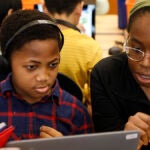
Week of Code Exposes Students to Careers in Computer Science
They came. They saw. They coded.
Hundreds of students around the district participated in Week of Code in December with the help of Amazon and Google volunteer engineers for Computer Science Education Week.
As part of the week, students got a one-hour introduction to computer science using fun tutorials to show that anybody can learn the basics. The Hour of Code lessons were designed to engage students at every grade level and introduce them to careers in science, technology, engineering and math (STEM).
Seattle Public Schools is dedicated to supporting students’ exploration of interests, strengths, and skills that will support them in the future.
There were 56 Amazon events across 35 SPS schools with 77 volunteers. Google provided 70-plus volunteers at more than 60 events with schools in Seattle and surrounding areas. More than half of these events were within SPS. Both companies led coding activities, while Google also offered career panels. In these panels, students – typically middle and high schoolers – learned about Google staffers’ backgrounds and roles, the industry, and projects at Google.
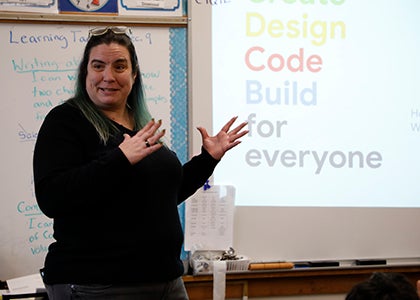
Start Them Young
Lisa Allphin, a third-grade teacher at Lowell Elementary, was first introduced to Hour of Code last January. She said when it comes to computer programming, waiting until high school to prepare students for college and career is too late.
“I think this coding week and coding in general with younger grades is essential,” Allphin said. “By the time kids get to high school, they already have set in their mind whether they understand … Whether they become experts at coding as a young child or not, as they get older, they won’t be afraid of it.”
For the coding activities, Google engineers shared stories of how they got started on their career pathways and about the growing need for engineers and coders in the tech field.
Allphin said many of her students live in shelters and find it hard to see themselves working at large tech companies like Google and Amazon. She wanted to give students the opportunity to see themselves in those roles.
“I don’t want them to get to high school and say, ‘Programming – that’s too hard,’ and so code is a way for everybody to have a step in the door.”
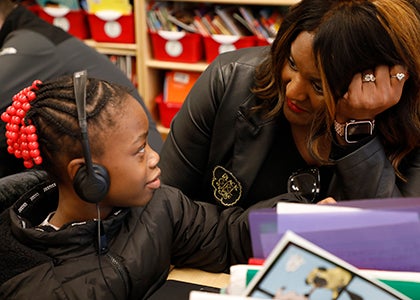
Dr. Keisha Scarlett is the assistant superintendent of academic for SPS. She had a front row seat to watch Lowell students create movies using Scratch, a programming software where you can create interactive stories, games, and animations. Dr. Scarlett saw firsthand the students’ excitement about coding.
“Having this opportunity to … show their creativity through coding is just one other entry point for them to think about how they can have agency over their learning,.” said Dr. Scarlett.
Dr. Scarlett also recognized the importance of representation in technology. The volunteers at Lowell were a mix of genders, ages, races, and levels of experience.
“Having the representation that Google brought out today is really impactful,” Dr. Scarlett said. “Many students don’t have the social networks that give them an opportunity to even see themselves in STEM careers, so just having this partnership in and of itself is really important.”
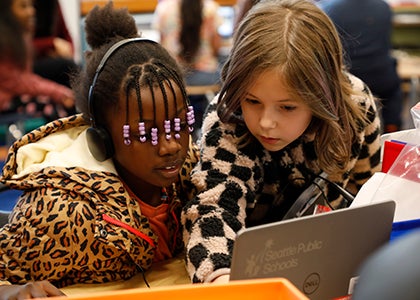
Something for All Ages
SPS is committed to ensuring students are prepared for college and career readiness after high school. Career and Technical Education (CTE) classes prioritize exploration of career options, development of work-readiness skills, and development of transitional technical skills.
Earl Bergquist is a CTE teacher at Garfield High School. He said students who may be interested in computer science should first seek out opportunities at their schools.
“There are clubs, there are robotics programs, in addition to our classes,” he said. “Even if you’re not sure you want to do computer programming, try out one of the lower-level classes.”
At Garfield, Amazon volunteers engaged students in activities centered around artificial intelligence (AI) using Amazon’s Alexa technology. The lesson opened with a question about the ways we interface with AI in our daily lives. Later, students received technical training on how to program machines to respond to different questions. Students walked away with a new understanding of how voice AI assistants work and with the ability to program Alexa in the future.
At Mercer Middle School, Emily Elasky teaches eighth grade science and robotics classes. The CTE teacher likes teaching STEM courses because of the challenges they offer students.
“I love STEM because of the creativity,” Elasky said. “Students can try new things. Once they’ve solved a challenge, they can come up with a new challenge to complete and try different solutions.”
Dr. Scarlett, who served as a teacher and principal before moving to the district’s central office, came from a STEM background. She said we are building a school system for a world that doesn’t exist yet.
“Our students are digital natives even earlier now than they have ever been before. When I look at what students are doing now … it’s absolutely amazing to me.”
